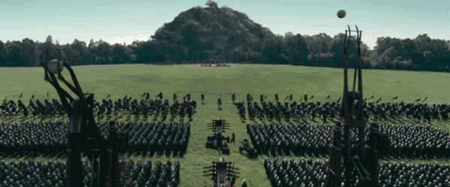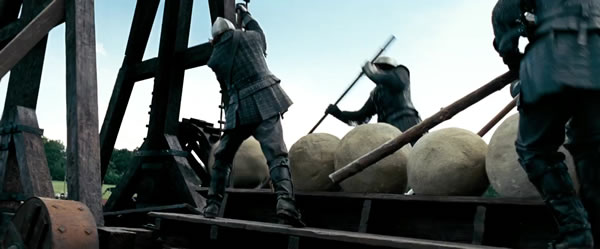Last month, I emphasized that nothing says medieval like a trebuchet when it comes to film. The Chronicles of Narnia: Prince Caspian (2008) turns notion on its head by enhancing the traditional trebuchet with an industrial-like enhancement.
In the climactic battle of the film, one of the armies employs a double-armed trebuchet that continually swings, seemingly using the weight of one arm to spin the whole machine like a water wheel.

While the physics of the machines seem impossible, the filmmakers weren’t trying to push pure fantasy. Director Andrew Adamson tells us in the DVD commentary,
We also made these machinegun trebuchets that actually do kind of work. They’re wound by people and they keep scooping up these boulders, which they can grab and fling. But it makes for a machine gun firing of boulders throughout the sequence, which was largely there to keep the dust levels up.
And if you look closer at the sequences, there are indeed gears and chains churning the arms around and round, as well as men loading massive stone balls one by one.

If we ignore the physics for a moment (remember, this is Narnia), we can draw several conclusions in the theme of trebuchets in medieval and fantasy productions.
First, the appearance of these trebuchets continues the medieval, or pre-modern feel of the Narnia world. Anyone familiar with trebuchets will recognize what they’re seeing and associate it with medieval. Everyone else will see a powerful, gunpowder-less weapon and thus, associate it with an older era.
Second, the creators have enhanced the trebuchets with the “machinegun” effect to give them a somewhat industrial feel to the army utilizing them. Without gunpowder, the filmmakers manage to demonstrate an industrial edge in this army through the mechanics of the giant chain, gear, and rate of fire. It is a fine line to walk and the result is a unique twist on the trebuchet as a medieval historicon, which both portrays medievalism to the audience while appearing technologically advanced.
